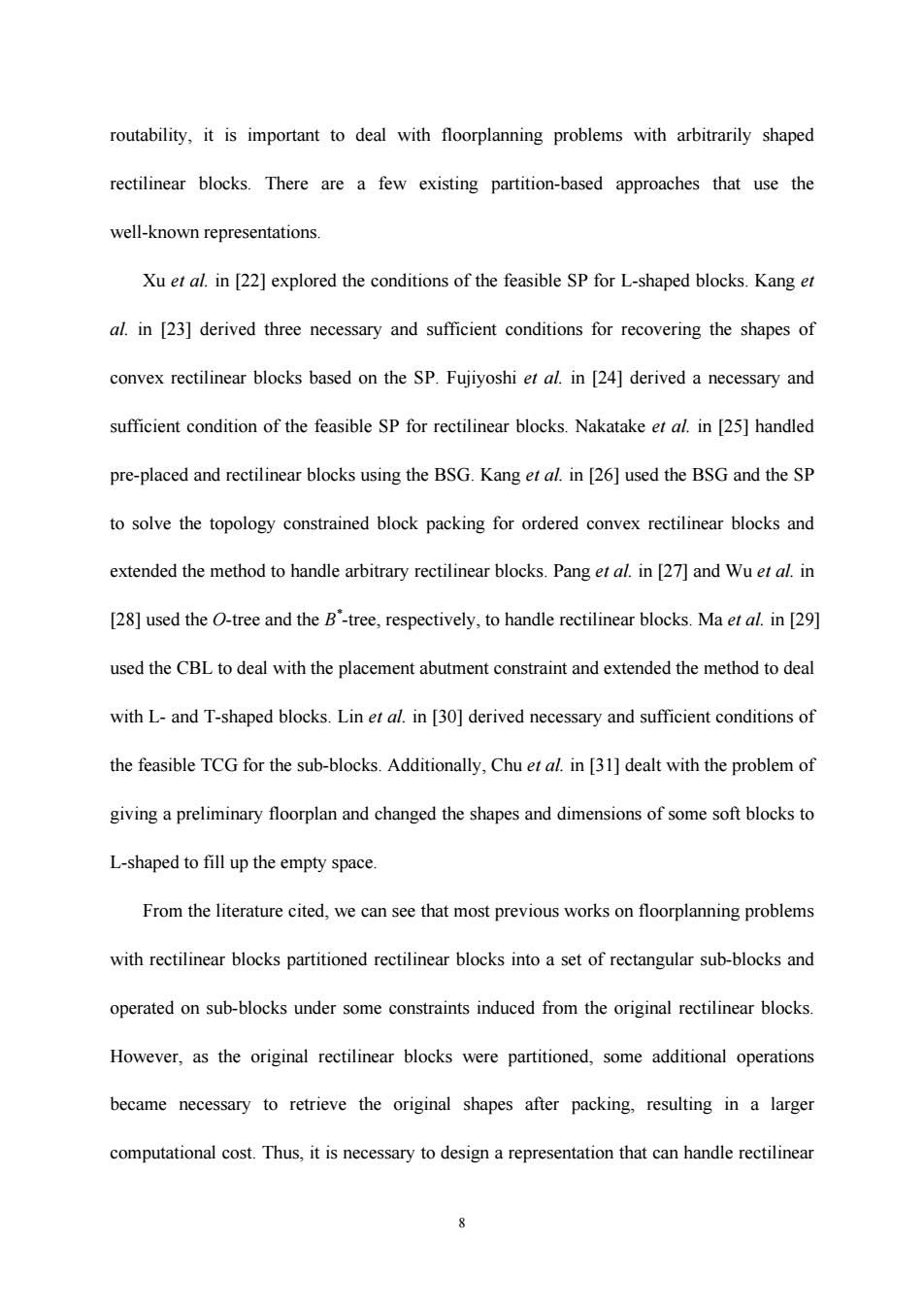正在加载图片...

routability,it is important to deal with floorplanning problems with arbitrarily shaped rectilinear blocks.There are a few existing partition-based approaches that use the well-known representations. Xu et al.in [22]explored the conditions of the feasible SP for L-shaped blocks.Kang et al.in [23]derived three necessary and sufficient conditions for recovering the shapes of convex rectilinear blocks based on the SP.Fujiyoshi et al.in [24]derived a necessary and sufficient condition of the feasible SP for rectilinear blocks.Nakatake et al.in [25]handled pre-placed and rectilinear blocks using the BSG.Kang et al.in [26]used the BSG and the SP to solve the topology constrained block packing for ordered convex rectilinear blocks and extended the method to handle arbitrary rectilinear blocks.Pang et al.in [27]and Wu et al.in [28]used the O-tree and the B'-tree,respectively,to handle rectilinear blocks.Ma et al.in [29] used the CBL to deal with the placement abutment constraint and extended the method to deal with L-and T-shaped blocks.Lin et al.in [30]derived necessary and sufficient conditions of the feasible TCG for the sub-blocks.Additionally,Chu et al.in [31]dealt with the problem of giving a preliminary floorplan and changed the shapes and dimensions of some soft blocks to L-shaped to fill up the empty space. From the literature cited,we can see that most previous works on floorplanning problems with rectilinear blocks partitioned rectilinear blocks into a set of rectangular sub-blocks and operated on sub-blocks under some constraints induced from the original rectilinear blocks. However,as the original rectilinear blocks were partitioned,some additional operations became necessary to retrieve the original shapes after packing,resulting in a larger computational cost.Thus,it is necessary to design a representation that can handle rectilinear 88 routability, it is important to deal with floorplanning problems with arbitrarily shaped rectilinear blocks. There are a few existing partition-based approaches that use the well-known representations. Xu et al. in [22] explored the conditions of the feasible SP for L-shaped blocks. Kang et al. in [23] derived three necessary and sufficient conditions for recovering the shapes of convex rectilinear blocks based on the SP. Fujiyoshi et al. in [24] derived a necessary and sufficient condition of the feasible SP for rectilinear blocks. Nakatake et al. in [25] handled pre-placed and rectilinear blocks using the BSG. Kang et al. in [26] used the BSG and the SP to solve the topology constrained block packing for ordered convex rectilinear blocks and extended the method to handle arbitrary rectilinear blocks. Pang et al. in [27] and Wu et al. in [28] used the O-tree and the B* -tree, respectively, to handle rectilinear blocks. Ma et al. in [29] used the CBL to deal with the placement abutment constraint and extended the method to deal with L- and T-shaped blocks. Lin et al. in [30] derived necessary and sufficient conditions of the feasible TCG for the sub-blocks. Additionally, Chu et al. in [31] dealt with the problem of giving a preliminary floorplan and changed the shapes and dimensions of some soft blocks to L-shaped to fill up the empty space. From the literature cited, we can see that most previous works on floorplanning problems with rectilinear blocks partitioned rectilinear blocks into a set of rectangular sub-blocks and operated on sub-blocks under some constraints induced from the original rectilinear blocks. However, as the original rectilinear blocks were partitioned, some additional operations became necessary to retrieve the original shapes after packing, resulting in a larger computational cost. Thus, it is necessary to design a representation that can handle rectilinear